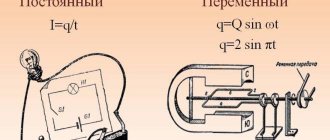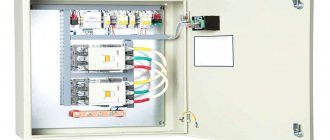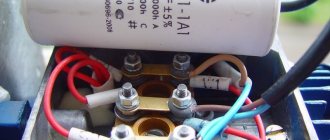I once wrote about the wiring for the hob, that I was installing a new one, etc. Then I really screwed up with the cable - I didn’t expect that the induction cooker would consume 7.5 kW. And it cannot be plugged into a regular 16A (Ampere) outlet. Some time passed, and a guy wrote to me that he also installs a hob, and wants to connect it to a regular 16A outlet? The question was something like this: will the outlet withstand the voltage from the stove? And 16 A is how many kilowatts ? Just awful! I didn’t expose the guy, but such a connection could burn down your apartment! Be sure to read on...
Guys, if you don’t know what and how it’s calculated! If at school it was bad with physics, and especially with electricity! Then it’s better for you not to get involved in connecting electric stoves! Call someone who understands!
Now let's talk about voltage and current!
Types of current
There are two types of current - direct and alternating. To understand the difference and determine whether the outlet has direct or alternating current, you should delve into some technical features. Alternating current has the property of changing in direction and magnitude. Direct current has stable qualities and direction of movement of charged particles.
Alternating current comes out of the power plant generators with a voltage of 220-440 thousand volts. When approaching an apartment building, the current is reduced to 12 thousand volts, and at the transformer station it is converted to 380 volts. The voltage between phases is called linear. The low-voltage section of the step-down substation produces three phases and a zero (neutral) wire. Energy consumers are connected from one of the phases and the neutral wire. Thus, single-phase alternating current with a voltage of 220 volts enters the building.
The distribution diagram of electricity between houses is presented below:
In the home, electricity is supplied to the meter, and then through automatic machines to the boxes of each room. The boxes contain wiring throughout the room for a couple of circuits - electrical outlets and lighting equipment. The machines can be provided one for each room or one for each circuit. Taking into account how many amperes the outlet is designed for, it can be included in a group or connected to a dedicated circuit breaker.
Alternating current accounts for approximately 90% of all electricity consumed. Such a high specific gravity is due to the peculiarities of this type of current - it can be transported over considerable distances by changing the voltage at substations to the required parameters.
Sources of direct current are most often batteries, galvanic cells, solar panels, thermocouples. Direct current is widely used in local networks of automobile and air transport, in computer electrical circuits, automatic systems, radio and television equipment. Direct current is used in contact networks of railway transport, as well as on ship installations.
Note! Direct current is used in all electronic devices.
The diagram below shows the fundamental differences between direct and alternating currents.
Practical significance of the differences
This is what it is, alternating and direct current. It's not that difficult to figure out what the difference is. There is a difference and a very big one. A DC source will not allow you to connect a welding, or any other, transformer. When calculating insulation or capacitors, the maximum voltage value, rather than the effective voltage, is taken for breakdown. After all, the thought may certainly arise: “why do you need 400-volt capacitors in a 220-volt network?” Here is the answer, in a 220 V network the voltage reaches 380 V during normal operation, and in the event of a minor failure, 400 V is not the limit.
People have long been accustomed to the benefits of electricity and many do not care what current is in the outlet. On the planet, 98% of electricity generated is alternating current. It is much easier to produce and transmit over significant distances than constant. In this case, the voltage can change many times in value down and up. The current strength significantly affects the losses in the wires.
Transmission of electricity over a distance
The parameters of the home network are always known: alternating current, voltage 220 volts and frequency 50 hertz.
They are mainly suitable for electric motors, refrigerators and vacuum cleaners, as well as incandescent lamps and many other devices. Many consumers operate at a constant voltage of 6-12 volts. This especially applies to electronics. But the power supply of the devices must be of the same type. Therefore, for all consumers, the current in the outlet must be variable, with the same voltage and frequency.
Home electrical network parameters
The main parameters of electricity are its voltage and frequency. The standard voltage for home electrical networks is 220 volts. The generally accepted frequency is 50 hertz. However, in the USA a different frequency value is used - 60 hertz. The frequency parameter is set by the generating equipment and is unchanged.
The voltage in the network of a particular house or apartment may be different from the nominal value (220 volts). This indicator is influenced by the technical condition of the equipment, network loads, and substation load. As a result, the voltage may deviate from the specified parameter in one direction or another by 20–25 volts.
Voltage surges negatively affect the performance of electrical household appliances, so it is recommended that connections to the home network be made through voltage stabilizers.
How many amperes are in a regular battery?
A standard AA battery has a charge of 1.5 volts. This type of battery can produce current up to one and a half (1.5) amperes.
Interesting materials:
How to receive a tax payment? How to get a tax deduction through your personal account? How to get a tax deduction for rent? How to get a password for your personal account at the tax office? How to obtain a tax registration certificate for a legal entity? How to receive a tax notice? How to get an extract from the tax office via the Internet? How to recover tax arrears? How to calculate land tax 2022? How to calculate VAT tax?
Current load
All sockets have a certain marking, by which you can judge the permissible current load. For example, the designation "5A" indicates a maximum current of 5 amperes. Acceptable indicators must be observed, since otherwise the equipment may fail, including fire.
The markings on the sockets are shown in the figure below:
All legally sold electrical appliances are accompanied by a passport indicating the power consumption or current load rating. The largest consumers of electricity are household appliances such as air conditioners, microwave ovens, washing machines, electric stoves and ovens. For normal operation, such devices will need an outlet with a load of at least 16 amperes.
If the documentation for electrical household appliances does not contain information about the consumed amperes (current strength in the outlet), the required values are determined using the electric power formula:
The power indicator is in the passport, the network voltage is known. To determine electricity consumption, you need to divide the power indicator (indicated only in watts) by the voltage value.
How to save household appliances from random emergencies
Manufacturers have been producing voltage control relays of different brands for a long time. It occupies a small place in the apartment panel and silently waits in the wings: when a critical moment comes, it automatically removes power from the entire apartment.
All consumers find themselves de-energized and saved from an accident in the electricity supply system that occurs at the most unexpected moment.
Among such models, products from the RBUZ company are gaining popularity, allowing visual control of voltage, current and power consumption at the same time (in the photo 223 volts, 16.7 amperes, 3.7 kilowatts “kW”). The built-in voltmeter, ammeter, and wattmeter work.
This convenient and useful feature helps you quickly and efficiently evaluate system performance in normal and emergency situations without performing additional electrical measurements.
By the way, the rated current of this model is 63 amperes (more than enough), frequency 50Hz. There are simpler RKN relays on sale that eliminate overvoltage surges. They can be installed, but the stabilizer is unlikely to help if the zero is broken. Think about what is safer.
Types of sockets
Sockets are designed to create contact between the electrical network and household appliances. They are manufactured to provide reliable protection against accidental contact with live elements. Modern models are most often equipped with protective grounding, presented in the form of a separate contact.
According to the installation method, there are two types of sockets - open and hidden. The choice of socket type is largely determined by the type of installation. For example, when organizing external wiring, overhead open sockets are used. Such fittings are easy to install and do not require niches for socket boxes. Built-in models are more attractive from an aesthetic point of view and safer, since the current-carrying elements are located inside the wall.
Sockets differ in current value. Most units are designed to operate at 6, 10, or 16 amps. Old Soviet-made models are designed for only 6.3 amperes.
Note! The maximum possible current for the outlet must be in accordance with the power of the consumer connected to the electrical network.
Requirements for plug connections
To connect an electrical appliance to the network, a socket and plug are respectively a source and receiver of energy, forming a plug connection. The following requirements apply to it.
Reliable contact. A weak connection leads to overheating and failure.
It is also important to ensure reliable fixation against spontaneous disconnection. Here it is convenient to use spring contacts in the socket. Isolation of current-carrying parts from each other. Protection against touching live parts with hands or other objects
To protect against children, sockets are provided with special curtains that open only when the plug is inserted. Ensuring polarity when connecting. This is important if the connection carries direct current or the device is used in combination with a single-pole switch. The design of the socket does not allow incorrect connection. Availability of grounding for devices of protection class 1. It is important to properly connect the grounding in sockets.
Methods for measuring voltage and current
To measure voltage and current, the following methods are used:
- The simplest method is to connect an electrical appliance of the appropriate voltage to an outlet. If there is current in the outlet, the appliance will function.
- Voltage indicator. This device can be single-pole and take the form of a special screwdriver. Two-pole indicators with a pair of contactors are also available. A single-pole device detects the phase in the socket contact, but does not detect the presence or absence of a zero. The bipolar indicator shows the current between phases, as well as between zero and phase.
- Multimeter (multitester). Using a special tester, measurements are made of any type of current present in the outlet - both alternating and direct. Also check the voltage level with a multimeter.
- Control lamp. Using a lamp, the presence of electricity in the outlet is determined, provided that the light bulb in the control device corresponds to the voltage in the outlet being tested.
The information listed above is quite sufficient for a general understanding of the principles of organizing the electrical network in the house. You should begin carrying out any electrical work only in compliance with all safety measures and with the appropriate qualifications.
General definitions
The physical process in which charged particles move in an orderly (directional) manner is called electric current. It is usually divided into variable and constant. For the first, the direction and magnitude remain unchanged, but for the second, these characteristics change according to a certain pattern.
The above definitions are greatly simplified, although they explain the difference between direct and alternating current. To better understand what this difference is, it is necessary to provide a graphical representation of each of them, as well as explain how the alternating electromotive force is generated in the source. To do this, let us turn to electrical engineering, or rather its theoretical foundations.











